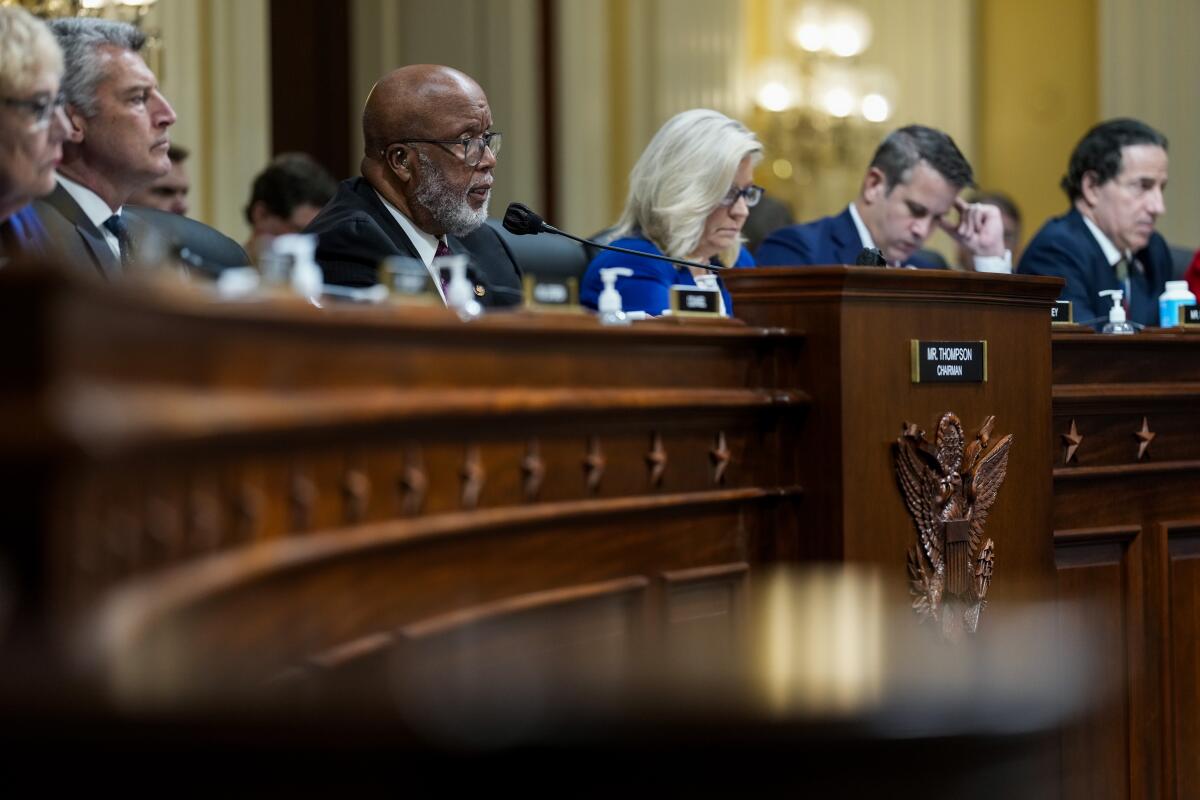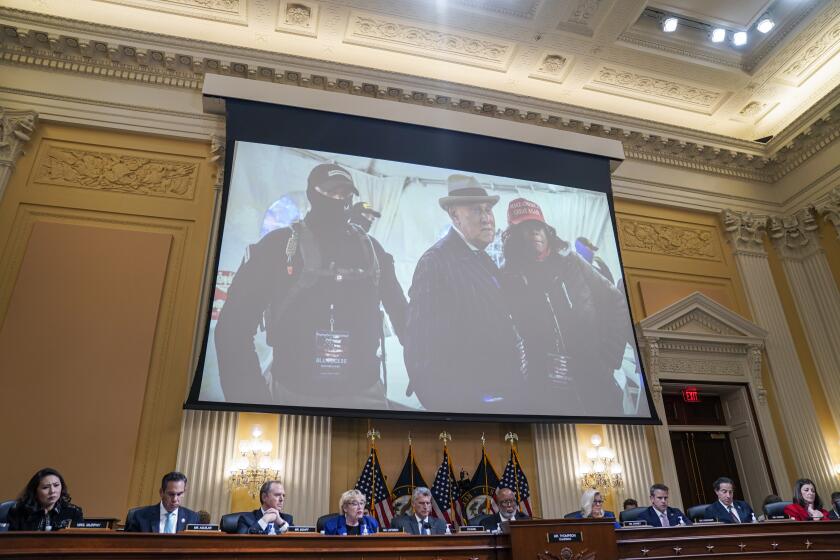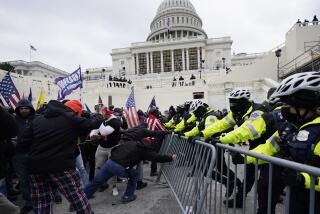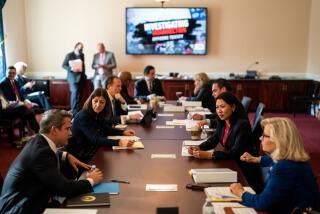Jan. 6 committee votes to subpoena Trump: ‘He is required to answer for his actions’

WASHINGTON — The House Jan. 6 select committee voted unanimously Thursday to issue a subpoena to former President Trump, capping off what could be its final hearing by laying out the case that Trump’s attempts to overturn the 2020 election were premeditated.
The move follows months of hearings by the committee to make the argument that blame for the insurrection should be placed squarely on Trump’s efforts to stay in power despite knowing he’d lost the election. Thursday’s hearing summarized and built upon evidence of that scheme.
After months of internal debate over whether to call Trump to testify, committee Chair Bennie Thompson (D-Miss.) said the panel had determined that speaking with the former president was necessary.
“The committee needs to do everything in our power to tell the most complete story possible and present recommendations to help ensure nothing like Jan. 6 ever happens again. We need to be fair and thorough and gain a full context for the evidence we’ve seen. But the need for this committee to hear from Donald Trump goes beyond our fact-finding,” Thompson said. “He is required to answer for his actions.”
Rep. Liz Cheney (R-Wyo.), who has been abandoned by the Republican Party and lost the primary in her reelection bid after taking a leading role in the investigation as the committee’s vice chair, formally requested the subpoena.
Cheney asked the public to keep in mind three facts revealed in the hearings: that Trump had long planned to claim fraud if he lost; that he knew his claims of fraud were false and had failed to be proved in court but made a conscious decision to continue claiming the election was stolen; and that the people who ultimately stopped his attempts to stay in power were his fellow Republicans.
She emphasized that the country couldn’t rely on the hope that people of conviction will be in positions to stop such a threat to democracy from happening again.
“Our duty today is to our country and our children and our Constitution. We are obligated to seek answers directly from the man who set this all in motion,” Cheney said.
Trump is likely to fight the subpoena in court. With just over two months left before the committee is set to disband, such a legal challenge would leave the panel little chance of hearing firsthand from the former president as part of its investigation.
Trump responded to the vote on his social media platform, Truth Social, by questioning why the committee waited so long to ask him to testify.
The committee’s ninth hearing this year, possibly its final one, focused on Trump’s role in the scheme to keep himself in power and provided a sweeping summation of the facts disclosed in the previous hearings.
Trump planned “well in advance” to declare victory on election night, regardless of the vote count, said Rep. Zoe Lofgren (D-San Jose).
“This big lie — President Trump’s effort to convince Americans that he had won the 2020 election — began before the election results even came in. It was premeditated. It was not based on … results or any fraud, if there was any actual problems with voting,” Lofgren said. “It was a plan concocted in advance to convince his supporters that he won, and the people who seemingly knew about the plan in advance would ultimately play a significant role in the events of January.”
Each of the nine committee members led a portion of the hearing by presenting fresh testimony from new and old witnesses, as well as new evidence obtained from the Secret Service and never-before-seen video of the riot and of the activities of congressional leaders and Trump’s allies in the days around Jan. 6.
Committee leaders described the hearing’s goal as a step back to look at the entire plan to keep Trump in power, covering the span of time from before the 2020 election until after the Jan. 6 insurrection. Each previous hearing focused on an aspect of Trump’s attempts to overturn the election.
“The central cause of Jan. 6 was one man, Donald Trump, who many others followed,” Cheney said. “None of this would have happened without him. He was personally and substantially involved in all of it. Exactly how did one man cause all of this? Today we will focus on President Trump’s state of mind, his intent, his motivations and how he spurred others to do his bidding.”
Thursday was the committee’s first public hearing in nearly three months. In the interim, public attention has been seized by news of the Justice Department’s accelerating investigation into the insurrection and the scheme to cast doubt on the election results and use false electors to keep Trump in office, and on the FBI’s efforts to recover classified materials that were improperly — and possibly illegally — stored at Trump’s Florida estate after he left office.
Key takeaways from Thursday’s hearing of the House committee investigating the Jan. 6 Capitol insurrection.
No witnesses testified at Thursday’s hearing, but the committee showed new clips from the more than 1,000 depositions it has collected, along with video captured by Danish filmmakers who followed conservative provocateur and longtime Trump confidant Roger Stone for two years filming a documentary. Stone was shown to have ties to the Proud Boys — a far-right militant group that includes members convicted for their Jan. 6 activities.
In one clip, Stone said before the election, “F— the voting. Let’s get straight to the violence.”
The committee also played video of another longtime Trump advisor, Stephen K. Bannon, saying before the election that Trump planned to claim he’d won regardless of the results.
“[Trump’s] going to declare victory. That doesn’t mean he’s the winner. He’s just going to say he’s the winner.... He’s going to sit right there and say they stole it,” Bannon said. “If Biden is winning [on election day], Trump is going to do some crazy s—.”
Trump privately acknowledged to aides that he had lost while publicly claiming he had won, the committee said as it detailed his attempt to immediately withdraw all American troops from Afghanistan and Somalia before Joe Biden’s inauguration as president that Jan. 20.
“Knowing that he had lost and that he had only weeks left in office, President Trump rushed to complete his unfinished business,” said Rep. Adam Kinzinger (R-Ill.).
The committee also showed newly obtained documents from the National Archives and the Secret Service. According to the records, Trump consulted with one of his outside advisors, conservative activist Tom Fitton of Judicial Watch, about the strategy for election night a few days beforehand. In a draft statement proposed that Oct. 31, Fitton encouraged Trump to say, “We had an election today — and I won,” and to demand that all votes not counted on election day be rejected.
Using some of the hundreds of thousands of records obtained from the Secret Service, Rep. Adam B. Schiff (D-Burbank) said the agency knew about the potential for violence on Jan. 6 at least 10 days before the attack.
One tip sent to the Secret Service warned about the Proud Boys’ plans and said: “Their plan is to literally kill people. Please please take this tip seriously and investigate further.”
Schiff said that “certain ... Secret Service witnesses” testified to the committee that there was no intelligence indicating there would be violence that day that threatened those in its protection.
“Evidence strongly suggests that this testimony is not credible,” Schiff said.
Schiff also detailed multiple Secret Service communications from Jan. 6 about people in the crowd wearing ballistic gear and carrying handguns and rifles. Some agents remarked on the high chances of violence as the crowd turned toward the Capitol.
The committee again noted that Trump had been told about the potential for violence and that many in the crowd were armed, but that he rallied his supporters to go to the Capitol anyway. The panel also showed that he’d repeatedly ordered his Secret Service detail to let him join supporters marching to Capitol Hill, and that he‘d spent hours watching the violence unfold on television, but never contacted national security officials who were scrambling to formulate a National Guard response without him.
The committee contrasted Trump’s inaction during the riot by playing extended, previously unaired video of House Speaker Nancy Pelosi (D-San Francisco) making calls to national security officials from a secure room, pleading for intervention, as Senate Majority Leader Charles E. Schumer (D-N.Y.) and House Majority Leader Steny H. Hoyer (D-Md.) did the same in the background.
“Just pretend that it was the Pentagon or White House under siege,” Pelosi was shown saying at one point when an unidentified person on the phone said he was waiting for permission to mobilize.
The video included Pelosi and Vice President Mike Pence talking with each other by phone about plans to resume certifying the presidential election results as soon as the building could be secured and human excrement left by Trump supporters could be cleaned out of the House chamber.
Committee members have indicated that, barring additional information coming to light, this is probably the panel’s last hearing. But committee aides balked at reporters’ attempts to label it their closing argument, adding that more evidence or testimony could surface before the committee presents its final report by the end of the calendar year.
Cheney said the committee was still considering whether to recommend to the Justice Department that it file criminal charges.
Republicans are not expected to renew the committee if they regain control of the House in January.
Rep. Jamie Raskin (D-Md.) told reporters after Thursday’s hearing that the holes remaining in the investigation primarily relate to what Trump was doing and saying in private between election day and Jan. 6.
“One way of addressing the 30 or so witnesses who took the 5th [Amendment] when it came to Donald Trump’s own actions is to call Donald Trump in himself,” Raskin said. “It’s hard for me to imagine any American citizen being accused of essentially trying to overthrow his or her own government who wouldn’t welcome the opportunity to come forward and to testify.”
The televised vote came after the panel had wavered for months over whether to subpoena Trump or Pence, though members said they were united in their thinking that giving Trump a chance to speak was the right decision.
The move is not without precedent: Other presidents have been subpoenaed to testify before Congress. Raskin added that he didn’t “want to believe” that Trump would fight the subpoena.
“We haven’t discussed that.… But I’ll say this: We certainly have litigated in the past,” he said. “And I think we’ve got a pretty unbroken track record of winning our cases, because all we’re asking people to do is to come forward and testify, and the Supreme Court has been perfectly clear that Congress has the power to do that.”
Times staff writer Anumita Kaur contributed to this report.
More to Read
Get the L.A. Times Politics newsletter
Deeply reported insights into legislation, politics and policy from Sacramento, Washington and beyond. In your inbox three times per week.
You may occasionally receive promotional content from the Los Angeles Times.












